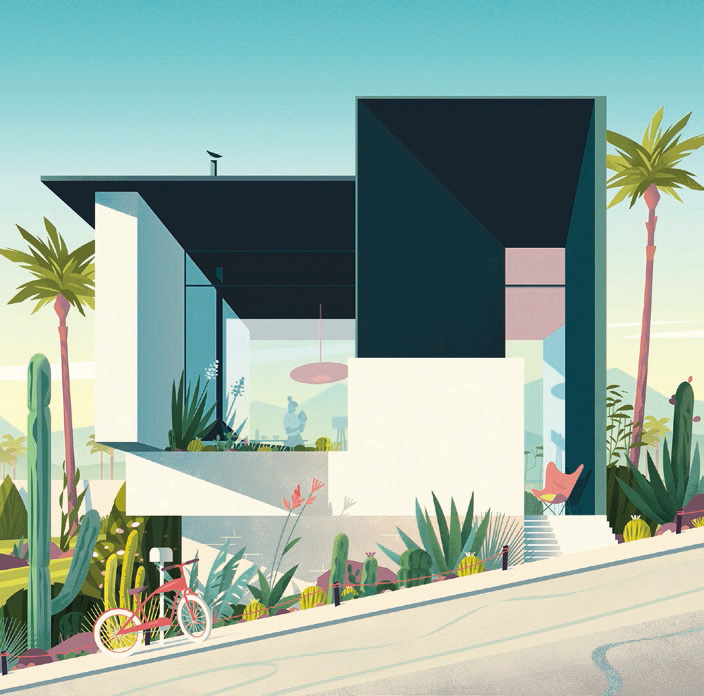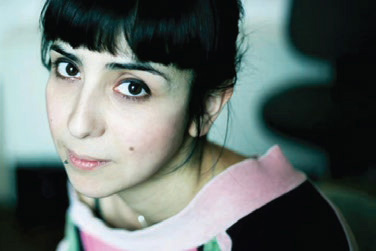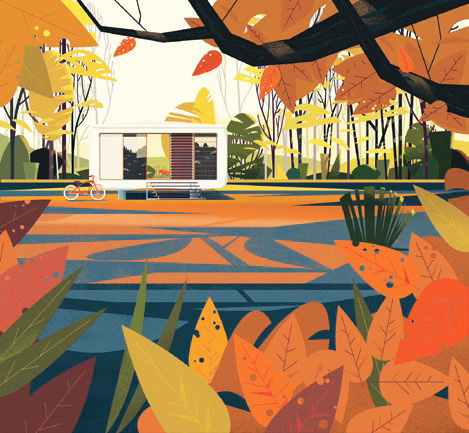Architecture of Dreams
 |
|
|
It’s an image that just shouts California—a glass-walled house with simple geometries, a mother and child inside beneath a George Nelson lamp, a butterfly patio chair at the entry, cacti and palm trees alongside.
But where in California? Where Palm Springs and San Francisco meet?
“The cover of Focus, a French lifestyle magazine, was offered to me as a carte blanche,” says the artist, Marie-Laure Cruschi. “The only request made was to invite people to dream through architecture. This illustration embodies a real fantasy, that of the contemporary house inherited from Californian modernism which symbolizes an ideal of life throughout the world.”
From her Paris studio overlooking the Canal de l’Ourcq, dotted with pleasure craft, the artist ranges widely.
 |
She’s created images of Yosemite, New York City, industrial plants in Scandinavia, bucolic landscapes near the Fukushima Daiichi nuclear plant, and life beneath the sea.
There’s a joy to her work that suggests the whimsy of mid-20th children’s books. One children’s book author was a major influence, Hélène Poirié, who illustrated the 1956 book Mon Larousse en Images.
“Because, between six and ten years old, when I started to draw, I often took [‘Mon Larousse’] out to look at the illustrations that I used to illustrate my homework,” Cruschi says. Another mid-century influence came from California itself.
 |
“When I was 22 I discovered Julius Shulman's photographic work on modern architecture. It was through its prism that I discovered the Case Study houses and the avant-garde of modern Californian architecture. It was a revelation for me,” Cruschi says.
“I was fascinated by the aesthetic, from the lines of force, the play of composition, the contrasts between full and fast, shadow and light, as well as the dialog offered between architecture and nature. From that was born my interest in design and architecture.”
You could say that dialog characterizes Cruschi’s work and her career—and maybe her life. She trained, first at a school in Southern France, where she grew up near the mountainous Cévennes National Park, then at L’école Estienne, et l’école des Arts Décoratifs in Paris, and became a designer.
Originally, she says, her focus was less on the ‘figurative illustration’ for which she has become known than on the wider world of art, illustration, typography, and graphic design. “I gradually moved towards a stronger interest in the sensitive, the sensual, and the emotional,” she says.
 |
Over the years, Cruschi, now 37, has done illustration and design for such brands as Dior, Hermés, and Johnny Walker; and GQ, Esquire, and Wired magazines.
“I gradually slipped from designer to illustrator,” she says. In 2007 Cruschi started her own, one-person studio, Cruschiform. Cruschi sketches ideas in notebooks, develops them in pencil, and creates final illustrations on the computer.




